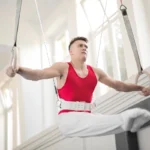Gymnastics rings turn every shoulder exercise into a full-body challenge. Because the rings move, your rotator cuff, scapular stabilizers, and core all have to work harder. You can build strength and muscle with very little equipment while training movement patterns that transfer to nearly every upper-body skill.
Below are five ring exercises that target the shoulders from multiple angles (anterior, lateral, and posterior delts), add serious triceps and upper-back strength, and progress smoothly from beginner-friendly to advanced.
Before You Start: Setup, Warm-Up, and Form Pillars
Ring height: For pressing variations, set rings around knee–hip height. Raise them to make the movement easier, lower them or elevate your feet to make it harder. For isometric holds like the planche lean or pike hold, keep the rings just above hip height so you can lock out your arms comfortably.
Warm-up (5–8 minutes):
- Wrist circles → scapular circles (protraction/retraction, elevation/depression)
- 10–15 slow ring support shrugs
- Band or towel external rotations (if available)
Non-negotiable cues:
- Straight elbows when prescribed
- Scapular depression (“shoulders down”)
- Gentle protraction (“reach through the floor”)
- Ribs down, hollow body line (glutes and abs engaged)
1) Pike Push-Up (Rings)
A ring staple for overhead pressing strength. The pike angle shifts the load toward the anterior delts and upper chest, while the instability fires up serratus and cuff muscles.
How to do it:
- Set rings at mid-shin to knee height with a neutral grip.
- Walk feet in and hinge at hips until your torso is angled steeply, hips high like an inverted “V.”
- Lower by bending elbows down and back (20–45°), bringing your head between your hands.
- Lightly touch a consistent bottom depth, then press back up, finishing with “head through” and active shoulders.
Coaching cues: “Hips high,” “elbows tuck,” “push the rings away,” “head through at the top.”
Progressions & regressions:
- Easier: Raise rings higher; bend knees into a deeper pike.
- Harder: Elevate feet on a box; lower rings for deficit; slow eccentrics (3–5s down); partial-ROM handstand push-up on rings.
Sets & reps: 3–5 × 6–12 (leave 1–2 reps in reserve). Rest 90–120s.
Common mistakes: Flaring elbows, collapsing hips, shrugging shoulders, cutting range of motion.
2) Narrow Push-Up (Rings)
A close-grip push-up on rings hammers the anterior delts and triceps while still engaging the chest. The neutral wrist and free scapulae are joint-friendly, and the instability boosts lockout strength.
How to do it:
- Set rings at knee height and assume a straight-body plank.
- Keep rings shoulder-width or slightly narrower, elbows tucked 20–30°.
- Lower with control until rings touch lower ribs/upper stomach.
- Press back to plank and finish tall.
Coaching cues: “Plank first, push second,” “ribs down,” “squeeze the rings in.” At lockout, practice a brief RTO (rings turned out) support.
Progressions & regressions:
- Easier: Raise rings; slight incline push-up.
- Harder: Feet elevated; bottom pauses; tempo reps (3–1–2); add weighted vest.
Sets & reps: 3–4 × 8–15, 60–90s rest.
Common mistakes: Sagging hips, elbows flaring, rings drifting away, loss of shoulder depression.
3) Face Pulls (Rings)
The ultimate shoulder-health move. Builds the posterior delts, traps, rhomboids, and rotator cuff to balance pressing strength and keep shoulders resilient.
How to do it:
- Set rings at chest height and lean back.
- Grab rings with neutral or thumbs-up grip.
- Pull elbows high and out, bringing rings toward forehead/eyes.
- Externally rotate at the finish so knuckles point slightly behind (like a “double biceps” pose).
Coaching cues: “Elbows high,” “squeeze between shoulder blades,” “don’t shrug.”
Variations: Face pull to Y-raise; one-arm face pulls; tempo 3–1–3.
Sets & reps: 3–4 × 12–20, 45–75s rest.
Common mistakes: Arching lower back, shrugging traps, using momentum.
4) Planche Lean (Rings)
A foundational isometric that builds straight-arm strength, wrist tolerance, and anterior shoulder power. Essential for advanced skills like the planche and handstand.
How to do it:
- Set rings just above hip height. Start in a locked-out support hold: elbows straight, shoulders depressed and protracted, ribs down.
- Lean shoulders forward past hands while maintaining a hollow body.
- Hold for time, then return to neutral.
Coaching cues: “Protract and press away,” “long body line,” “rings quiet and turned out.”
Progressions & regressions:
- Easier: Toes on floor or box; band-assisted.
- Harder: Increase lean distance; elevate feet; tuck planche support.
Holds: 5–8 × 10–20s (or clusters like 3×(15s on/15s off)). Rest 45–60s.
Common mistakes: Bent elbows, losing protraction, shrugging up, rings caving inward.
5) Pike Hold (Rings)
A static compression hold that builds anterior delt strength while hammering core and hip flexors. Perfect bridge to L-sits and press-to-handstands.
How to do it:
- From a support position, keep elbows locked and shoulders down.
- Lift legs to a 90° pike, knees straight, toes pointed.
- Hold steady without letting rings drift away from sides.
Coaching cues: “Rings in, shoulders down,” “zipper the legs,” “hips fold, chest tall.”
Progressions & regressions:
- Easier: Tuck pike; one-leg pike; small pulses.
- Harder: L-sit to pike switches; V-sit attempts; ankle weights; tempo lifts.
Holds: 4–6 × 10–30s, 45–75s rest.
Common mistakes: Bent knees, leaning back, rings drifting, shoulders shrugging.
Programming for Strength & Size
Weekly frequency: 2–3 sessions per week, with 48 hours between heavy pressing. Always include rear-delt/retraction work (like face pulls) to stay balanced.
Sample session (35–45 min):
- Warm-Up: Wrist prep, scapular circles, 2×15s support holds
- Planche Lean — 6×12–15s @ RPE 8, 60s rest
- Pike Push-Up — 4×8–12, 90–120s rest
- Narrow Push-Up — 3×10–15, 60–90s rest
- Face Pulls — 4×15–20, 45–75s rest
- Pike Hold — 4×15–25s, 45–75s rest
Progressive overload:
- Range: Lower rings or elevate feet before adding load.
- Tempo: Slow eccentrics (3–5s) or pauses.
- Volume: Add 1–2 reps per set, then reset difficulty.
- External load: Use a light vest/backpack once rep goals are met with perfect form.
Recovery & safety:
- If wrists or front shoulders ache, shorten sessions and emphasize face pulls/support shrugs.
- Train at 0–3 RIR for hypertrophy. Reserve all-out sets for your final round if form holds.
- Balance pushing with pulling (rows, pull-ups, front lever drills) for healthy shoulders.
Final Words
With just a pair of rings, you can build shoulders that are not only strong and muscular but also joint-stable and functional.
- Pike push-ups give you vertical pressing power.
- Narrow push-ups build delt and triceps drive.
- Face pulls bulletproof the upper back.
- Planche leans lay the foundation for elite skills.
- Pike holds integrate strength, stability, and core control.
Stick to these five movements, progress them patiently, and you’ll not only build bigger shoulders but also develop the joint integrity and strength base that unlocks advanced ring skills down the road.






